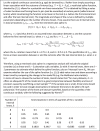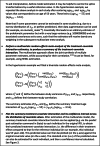Individual participant data meta-analysis to examine interactions between treatment effect and participant-level covariates: Statistical recommendations for conduct and planning
- PMID: 32350891
- PMCID: PMC7401032
- DOI: 10.1002/sim.8516
Individual participant data meta-analysis to examine interactions between treatment effect and participant-level covariates: Statistical recommendations for conduct and planning
Abstract
Precision medicine research often searches for treatment-covariate interactions, which refers to when a treatment effect (eg, measured as a mean difference, odds ratio, hazard ratio) changes across values of a participant-level covariate (eg, age, gender, biomarker). Single trials do not usually have sufficient power to detect genuine treatment-covariate interactions, which motivate the sharing of individual participant data (IPD) from multiple trials for meta-analysis. Here, we provide statistical recommendations for conducting and planning an IPD meta-analysis of randomized trials to examine treatment-covariate interactions. For conduct, two-stage and one-stage statistical models are described, and we recommend: (i) interactions should be estimated directly, and not by calculating differences in meta-analysis results for subgroups; (ii) interaction estimates should be based solely on within-study information; (iii) continuous covariates and outcomes should be analyzed on their continuous scale; (iv) nonlinear relationships should be examined for continuous covariates, using a multivariate meta-analysis of the trend (eg, using restricted cubic spline functions); and (v) translation of interactions into clinical practice is nontrivial, requiring individualized treatment effect prediction. For planning, we describe first why the decision to initiate an IPD meta-analysis project should not be based on between-study heterogeneity in the overall treatment effect; and second, how to calculate the power of a potential IPD meta-analysis project in advance of IPD collection, conditional on characteristics (eg, number of participants, standard deviation of covariates) of the trials (potentially) promising their IPD. Real IPD meta-analysis projects are used for illustration throughout.
Keywords: effect modifier; individual participant data (IPD); meta-analysis; subgroup effect; treatment-covariate interaction.
© 2020 The Authors. Statistics in Medicine published by John Wiley & Sons, Ltd.
Figures








References
-
- Riley RD, van der Windt D, Croft P, Moons KGM, eds. Prognosis Research in Healthcare: Concepts, Methods and Impact. Oxford, UK: Oxford University Press; 2019.
-
- Hudis CA. Trastuzumab—mechanism of action and use in clinical practice. N Engl J Med. 2007;357(1):39‐51. - PubMed
-
- Brookes ST, Whitely E, Egger M, Smith GD, Mulheran PA, Peters TJ. Subgroup analyses in randomized trials: risks of subgroup‐specific analyses; power and sample size for the interaction test. J Clin Epidemiol. 2004;57(3):229‐236. - PubMed
-
- Thompson SG, Higgins JP. Treating individuals 4: can meta‐analysis help target interventions at individuals most likely to benefit? Lancet. 2005;365(9456):341‐346. - PubMed
Publication types
MeSH terms
Grants and funding
LinkOut - more resources
Full Text Sources
